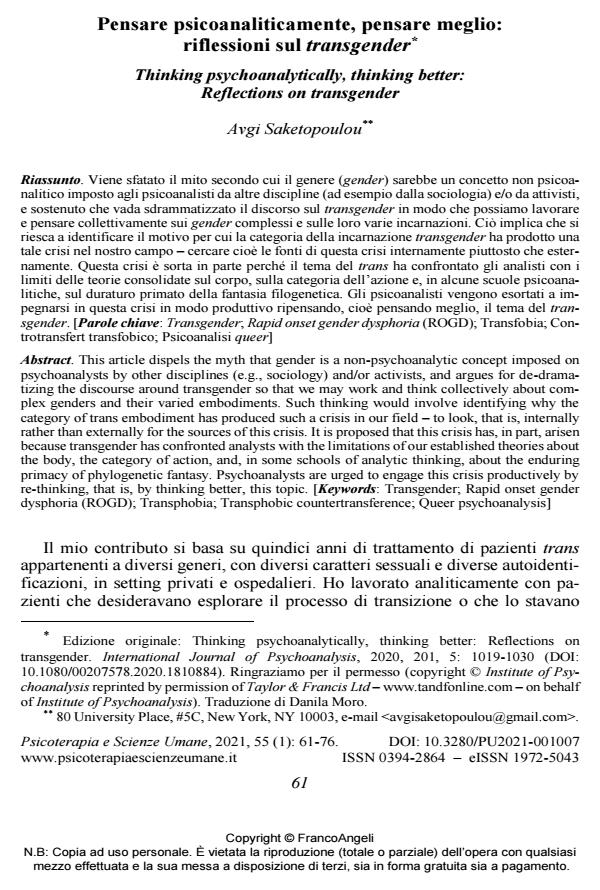Pensare psicoanaliticamente, pensare meglio: riflessioni sul transgender
Titolo Rivista PSICOTERAPIA E SCIENZE UMANE
Autori/Curatori Avgi Saketopoulou
Anno di pubblicazione 2021 Fascicolo 2021/1
Lingua Italiano Numero pagine 16 P. 61-76 Dimensione file 341 KB
DOI 10.3280/PU2021-001007
Il DOI è il codice a barre della proprietà intellettuale: per saperne di più
clicca qui
Qui sotto puoi vedere in anteprima la prima pagina di questo articolo.
Se questo articolo ti interessa, lo puoi acquistare (e scaricare in formato pdf) seguendo le facili indicazioni per acquistare il download credit. Acquista Download Credits per scaricare questo Articolo in formato PDF

FrancoAngeli è membro della Publishers International Linking Association, Inc (PILA)associazione indipendente e non profit per facilitare (attraverso i servizi tecnologici implementati da CrossRef.org) l’accesso degli studiosi ai contenuti digitali nelle pubblicazioni professionali e scientifiche
Viene sfatato il mito secondo cui il genere (gender) sarebbe un concetto non psicoanalitico imposto agli psicoanalisti da altre discipline (ad esempio dalla sociologia) e/o da attivisti, e sostenuto che vada sdrammatizzato il discorso sul transgender in modo che possiamo lavorare e pensare collettivamente sui gender complessi e sulle loro varie incarnazioni. Ciò implica che si riesca a identificare il motivo per cui la categoria della incarnazione transgender ha prodotto una tale crisi nel nostro campo - cercare cioè le fonti di questa crisi internamente piuttosto che esternamente. Questa crisi è sorta in parte perché il tema del trans ha confrontato gli analisti con i limiti delle teorie consolidate sul corpo, sulla categoria dell’azione e, in alcune scuole psicoanalitiche, sul duraturo primato della fantasia filogenetica. Gli psicoanalisti vengono esortati a impegnarsi in questa crisi in modo produttivo ripensando, cioè pensando meglio, il tema del transgender.
Parole chiave:Transgender; Rapid onset gender dysphoria (ROGD); Transfobia; Controtransfert transfobico; Psicoanalisi queer
Avgi Saketopoulou, Pensare psicoanaliticamente, pensare meglio: riflessioni sul transgender in "PSICOTERAPIA E SCIENZE UMANE" 1/2021, pp 61-76, DOI: 10.3280/PU2021-001007